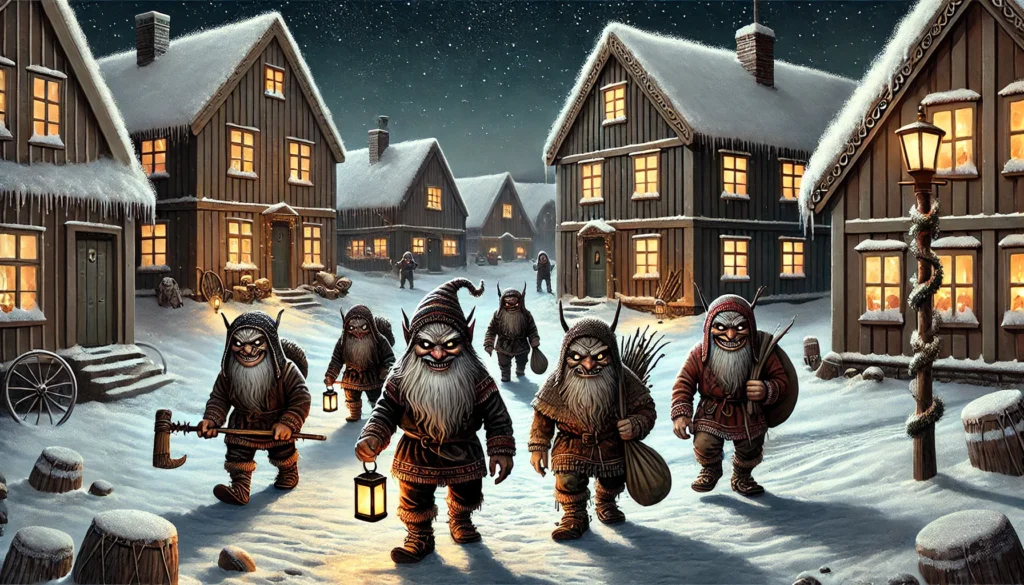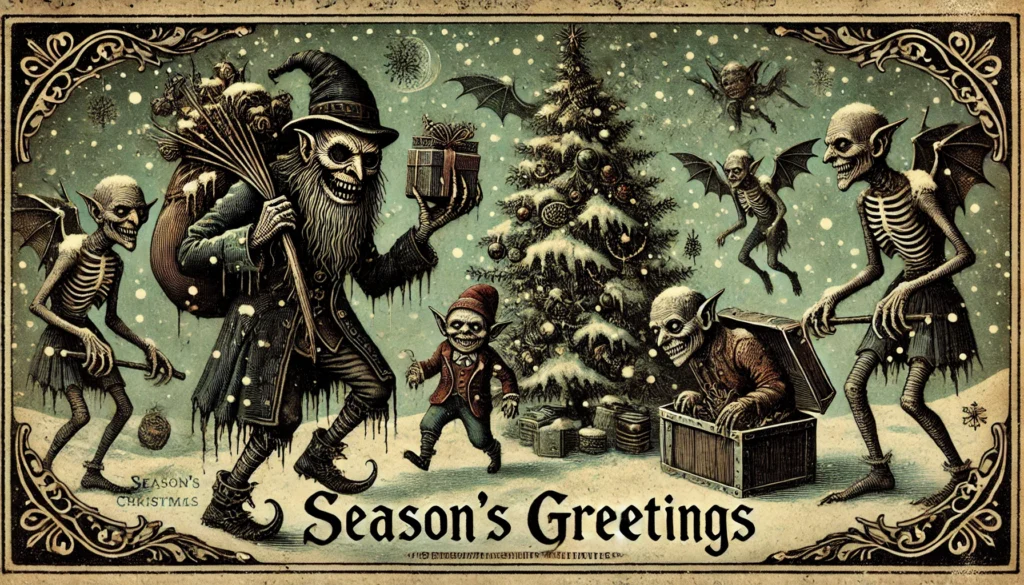
9 Spooky Christmas Traditions That Deserve a Comeback
The holiday season is known for joy, warmth, and cheer—but long ago, it also had a dark, eerie side. In the past, people marked Christmas with spooky traditions that celebrated the mysterious and supernatural. Today, bringing back some of these creepy customs could add a fresh, thrilling twist to our usual holiday festivities.
Here are nine spooky Christmas traditions that Americans and Canadians no longer practice, but definitely deserve a comeback.
Listen To The List
1. Telling Ghost Stories by the Fire

Tradition: Before Halloween became the go-to time for ghost stories, people shared their spookiest tales on Christmas Eve. Families would gather around the fire to tell ghost stories, often inspired by the long, dark nights and the idea that spirits roam more freely in winter.
Bring It Back: Invite friends and family to share ghost stories on Christmas Eve. Reading classic ghost tales or swapping personal spooky encounters can create an eerie, magical atmosphere.
2. Krampusnacht (Krampus Night)

Tradition: Celebrated on December 5th, Krampusnacht brings Krampus—the horned creature who punishes naughty children—into the holiday season. In parts of Europe, people dress as Krampus and parade through the streets, adding a thrill of fear to the festivities.
Bring It Back: Try a Krampus-themed event or costume contest. Embrace the scarier side of Christmas with decorations or costumes inspired by Krampus. It’s a perfect reminder that Christmas has a dark side, too.
3. The Yule Lads and Christmas Monsters

Tradition: In Iceland, thirteen mischievous Yule Lads visit children’s homes in the days leading up to Christmas. Each night, one of these pranksters leaves treats or tricks. There’s also Gryla, a terrifying giantess who punishes misbehaving kids in the stories.
Bring It Back: Add Yule Lad characters to your holiday decorations, or use the idea for an advent calendar that delivers both treats and harmless pranks. It’s a fun, spooky twist to make kids think twice about misbehaving.
4. Mari Lwyd (The Gray Mare)

Tradition: This Welsh tradition involves a skeletal horse figure, the Mari Lwyd, which “visits” homes in December. A group goes door-to-door, challenging people inside to a battle of wits with rhymes or songs. If they win, the household must let them in for treats and drinks.
Bring It Back: Imagine a creepy, ghostly caroling night! You could dress up in spooky costumes, knock on friends’ doors, and challenge them to friendly rhyming battles or ghostly songs in exchange for holiday treats.
5. Perchtenlauf (Parade of Perchten)

Tradition: In Austria, the Perchten—a blend of “good” and “evil” spirits—parade through town to scare away the dark forces of winter. This parade, known as the Perchtenlauf, includes masked characters who symbolize both light and darkness.
Bring It Back: Host a “Winter Spirits Parade” featuring costumes that represent winter spirits, both friendly and spooky. It’s a haunting way to mark the season while symbolically driving away the cold and darkness.
6. Creepy Christmas Cards

Tradition: Victorian Christmas cards sometimes featured eerie images, like creepy animals, strange goblins, and unsettling creatures, giving a dark twist to holiday greetings.
Bring It Back: Send modern creepy holiday cards to friends who appreciate a little fright with their festive greetings. Vintage designs or illustrations of eerie figures can add a unique, memorable touch to the usual holiday cheer.
7. Haunted Christmas Decorations

Tradition: In some old customs, people added spooky touches to their Christmas decorations, representing the spirits they believed roamed during the long winter nights.
Bring It Back: Mix in ghostly ornaments, like miniature phantoms or shadowy figures, with your holiday decorations. Adding a few dark, mysterious items to your tree or mantel could create a captivating look, blending the cozy and the creepy.
8. Wassailing the Trees (Orchard Wassailing)

Tradition: Orchard wassailing was an old English practice of singing and toasting to fruit trees in the winter to ensure a good harvest in the new year. People would sometimes dress up in ghostly costumes and offer bits of food to the spirits of the trees.
Bring It Back: Plan an outdoor gathering where friends or family “bless” the trees or garden for the coming year. Light some candles, share spooky stories, and honor the seasonal change by protecting the land from dark forces.
9. Celebrating the Bleak Season with Festive Haunts

Tradition: From December through mid-January, ancient cultures saw winter as a dangerous time when food was scarce, and spirits were near. Gatherings were held to reflect on survival through the harshest season, with a haunting atmosphere.
Bring It Back: Acknowledge the dark side of winter with a seasonal gathering where you tell haunting tales, light candles, and enjoy festive foods. Add eerie decorations or share ghostly tales to honor winter’s mystery and celebrate the season’s darker traditions.
Final Thoughts
These old traditions bring a spooky, supernatural edge to the season and add a whole new way to celebrate. Whether it’s dressing as Krampus, telling ghost stories, or mixing dark decorations with your holiday lights, bringing these traditions back can make for a Christmas season that’s cozy, mysterious, and just a little bit haunting.
Sources
Brown, Nathan Robert. The Complete Idiot’s Guide to World Mythology. Alpha Books, 2004.
Nissenbaum, Stephen. The Battle for Christmas. Vintage Books, 1996.
St. John, Warren. “Krampus, the Christmas Devil Who Punishes Naughty Children.” The New York Times, 21 Dec. 2015, www.nytimes.com/2015/12/22/arts/krampus-the-christmas-devil-who-punishes-naughty-children.html.
Williams, Victoria. Celebrating Life Customs Around the World: From Baby Showers to Funerals. ABC-CLIO, 2016.
“Mari Lwyd.” Museum of Welsh Life, National Museum Wales, www.museum.wales/articles/1334/Mari-Lwyd/.
Yohannan, Karen. “Perchtenlauf: Austria’s Scary Christmas Parade.” Smithsonian Magazine, 17 Dec. 2019, www.smithsonianmag.com/travel/perchtenlauf-austrias-scary-christmas-parade-180973819/.
Discover more from Ghostly Activities
Subscribe to get the latest posts sent to your email.
